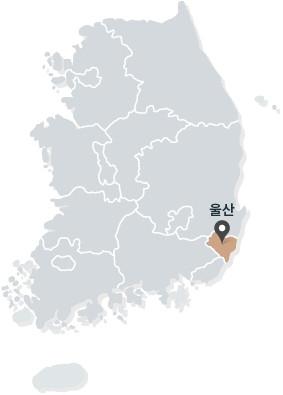Cost-effective seawater desalination
It’s a “customized solution” of Ulsan, by Ulsan, for Ulsan !
Problem
Metropolitan City Ulsan

In Ulsan, Petroglyphs of Bangudae found in 1971. This prehistoric remain is presumed to have been made from the Neolithic to the Bronze Age, mostly about whale hunting. This is the oldest whaling petroglyphs in the world.
However, before the petroglyphs was found, Sayeon Dam was built in 1965 at that location. So the petroglyphs was sunk. And due to the water level changing, weathering and erosion are repeatedly damaging the remains. So, through many discussions, Korea government decided to lower the water level to protect the petroglyphs.
The Petroglyphs locate from 53m to 57m, and the water level of dam was about 60m.
As result of agreement, Ulsan is going to lower the dam height to 47m and add 6m gate on the top of the dam.
But if this plan is implemented, Ulsan will lack water as much as the lowered water level.
The amount of insufficient water is 120 thousand ton of water per day.
Remember !! The problem is a local issue. We have to consider the characteristics of Ulsan. Also, the solution has to satisfy both Ulsan citizens and the government.
Background
Characteristics of Ulsan

Industrial Trends of KOREA
![금속시대]③ '산업 비타민' 희소금속…국가 미래 경쟁력 좌우 - 조선비즈](https://cloudfront-ap-northeast-1.images.arcpublishing.com/chosunbiz/ATYHMUYNXJPKUT24JOE7JSTQKI.jpg)
Korea recently focusing on rechargeable battery industry and it is also recognized worldwide. It can be confirmed by the global market share of rechargeable batteries. In rechargeable battery, rare earth elements are essential. For now, Korea is mostly depend on rare earth elements which are imported.
Seawater Desalination
Ulsan can use seawater as a surprisingly plentiful source of living water. However, the cost-efficiency problem to be solved in order to introduce seawater desalination.
Our solution
Our team suggests a way to make seawater desalination to be cost-effective.
Solution 1) “Hanju” salt company

Hanju is Ulsan’s representative salt company that obtains salt from Ulsan seawater.
After taking salt from sea water, Hanju releases 57,000 tons of fresh water every day. Since Ten years ago “Hanju” was looking for a place to use this lot of water, and we will use it.
By bring the water, we now have the source of water while the plant is being built. In addition, even after the plant is built, only 63,000 tons of water needs to be secured through seawater desalination, reducing the cost by 47.5%. Through the first solution Hanju, we solved some of the time problems of seawater desalination and part of the cost problem.
Solution 2) Obtaining Salts and Rare-earth metals
The first process of seawater desalination is pretreatment. We filtered large organisms through intake screens, and then filters Calcium, magnesium, silica, microorganisms, and others. At this stage, we can obtain magnesium which is critical for manufacturing mobilities and semiconductors.
According to our solution, left seawater goes to the salt pond. We can obtain salt efficiently using the high concentration seawater, and sell the salt as a specialty of Ulsan.
In addition, seawater contains a variety of rare-earth metals. We can extract Korea’s 10 strategic rare earth metals from seawaters during seawater desalination. And it can be a solution that corresponds with measures for the development of the rare metal industry of the KOREA government. We can develop secondary batteries, new energy, future cars with these rare earth metals.
Finally, we can solve the cost problem of seawater desalination.

Benefits of our solution
Direct Benefit
Ulsan needs 12,000 tons of sea water every day.
Research has shown that 41.86g of magnesium and 0.17mg of lithium can be extracted through 1L of seawater.
The monetary value of each day is as follows ;
Mg: $30139200, lithium: $2.7226
The amount of lithium obtained may feel very small, but the amount of lithium that could be extracted with seawater is 1.6 times larger than that of other mines, so the potential value is enormous when a plant to be extracted is well constructed.
Now, let’s consider the cost of operating a seawater desalination plant that will be reduced through 40,000 tons of water brought from Hanju. There will be many considerations, but I will show you how much profit can be made just by ro membrane used in the process.
The RO membrane ‘s life expectancy is proportional to the amount of salt filtered by the membrane. The original life expectancy is about five years, and NaCL accounts for half of the salt in seawater, so the life expectancy will be doubled. This savings amount to $2 million a year.
As a result, Our solution will reduce 30,144,680$ just per a day.
Indirect Benefit
Social benefits
- It corresponds to the government’s rare earth policy, which can give us a justification for building a seawater desalination plant.
- It is technologically feasible, practical solution
- It can satisfy both citizen and government
- It can be resolved within Ulsan without causing conflicts with other regions.
- Cooperation with local company (Hanju) can lead to regional economic development.
- Salt ponds and Bangudae petroglyphs can be used as tourism resources.
Environmental benefits
- While simply exporting concentrated water can have a negative impact on marine life, we can use our solutions to solve this problem.
- It can save energy because it uses a company that is already working.
- It can be a successful example of water supply using eco-friendly but economical seawater desalination.
Most powerful and localized solution for ULSAN
The problem of water shortage was solved while preserving cultural assets.
Ulsan will become a more attractive by highlighting the cultural value about salt and, and the industrial value related to secondary batteries.
Who are we?
Team WhATER
Team WhATER is a combination of what and water, which means “people(-er) who ask questions what is the limitations of water resources and solve them.”


We dream of solving the water problem in Ulsan, and even the problems of countries suffering from similar problems, through our solutions.





